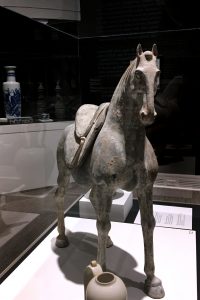
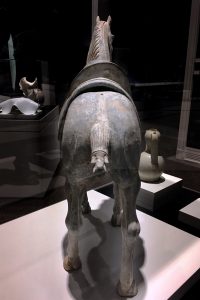
It stands upright—unsupported by posts or other objects and yet, by modest estimates, is over one thousand years old. The proud Horse with Saddle earthenware sculpture elegantly balances itself atop its four hooves, supported by its tall and sender limbs. Distinctly short ears and and a docked tail that juts slightly to the right accent the horse’s figure, keenly contrasting with its almost impossibly stilt-like forearms. Acquired by the Ackland Museum in 2008, Horse with Saddle hails from the time of China’s Tang Dynasty (618-906 CE). The piece’s age, however, is rather self evident, as narrow cracks split its worn facade. Horse with Saddle is neither uniform in texture nor in tone: it is almost anemic in color — its exterior coat varying from ashen to ecru — and boasts a finish that wavers from coarse to smooth. Upon inspection of its underbelly, the horse’s flank is unevenly hollowed out while it’s crest, head, and limbs are contrastingly solid. At the coup and just beneath the tail are deliberate holes, likely to have been constructed for firing purposes (to avoid explosion from trapped air within the piece). Sculpted complexities further grace the horse’s limbs, adding dimension and strength to its flexed tendons. Atop the horse rests its saddle, between the two of which lies vacant space: the saddle is detachable, and fails to conform to the build with precision. This lack of contact and exact fit between the horse and the saddle tell a story of separately fired constituent parts of the final piece. Although an imperfect final result, one can garner from this choice that the unknown artist maintained a deep understanding of his craft: with the technology available at the time of the piece’s creation, an ability to recognize the need for separate-part-firings that would maintain their shape rather well signifies a deftness in earthenware. Replete with delicate engraving and careful mimicry of fabric, the saddle, much like the stout-yet-detailed tail, stands in opposition to the otherwise minimally-carved frame. To be sure, the forehead, muzzle, and mane, are decidedly expressive. Along with emotive yet fixedly detached eyes, they provide a characteristic particularity that nevertheless does not command one’s attention—it is instead the ornamental aspects of Horse with Saddle that secure the observer’s line of sight.

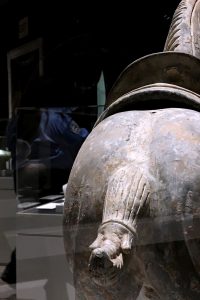
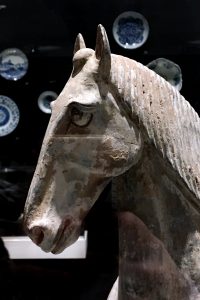
With research it can be gleaned that Horse with Saddle is likely to have been a funerary object, placed in a tomb with one who passed to “accompany the departed into the afterlife.” Under the assumption that this figure is indeed a tomb sculpture, we can better extrapolate from idiosyncrasies observed earlier. Traces of pigment still adorn Horse with Saddle, suggesting that details we can no longer observe had once lain atop both the smooth and carved portions of its frame. Deliberate choices between carving and painting, complexity and minimalism, were made by the skilled artisan who would have been commissioned (likely by a high member of society, as horses epitomized wealth and military adeptness during the Tang Dynasty) to create the figure. Such choices are made apparent as the fine carved detail of the horse’s saddle and tail are juxtaposed with an overall fluidity of frame, pointing to an intricate handmade process that purposively augmented symbols of affluence and strength within the piece (much the same as seemed true with the Large Painted Pottery Tomb Figure of a Soldier observed in class). Given that such tomb objects would have potentially existed in numerous quantities, decisions as to which elements of the figure were to be skillfully sculpted speak to the perceived importance of each constituent part: in short, it means something that ornamental portions of Horse with Saddle were more intricately crafted. It is distinctly plausible that increased attention was given to the tail and saddle in order to signify the wealth of the departed; likewise, the swift ease of the limbs’ tendons were sculpted as such to conjure notions of agility and brawn. Horse with Saddle’s poised frame establishes its dominance amongst a sea of still-adorned pieces in the Ackland’s Color Across Asia exhibit: its symbolic fortitude from funerary origins ring true even as it sits constrained by a plexiglass confine.
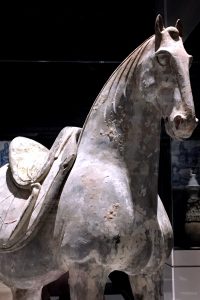
Source of the quote in the second paragraph is the Ackland Museum Object Guide for its exhibit Color Across Asia for Horse with Saddle, object 32. An electronic version can be found at: https://ackland.org/files/2012/03/G4ObjectGuide-4.pdf.